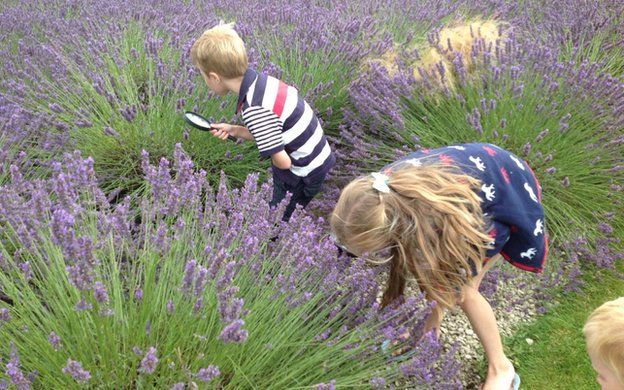Young citizen scientists reveal urban bee 'surprise'
- Published

A patch of lavender in a city centre sees more bumblebees than a patch in the country, according to preliminary results from a citizen science project.
Around 30,000 schoolchildren from 400 schools across the UK did the counts as part of the Big Bumblebee Discovery.
The first insights were announced at the British Science Festival.
Rather than generally higher bee numbers in cities, the results probably reflect a higher concentration of urban bees on more limited flowers.
High-density living
"Within cities, there are fewer floral resources," said Dr Michael Pocock from the Centre for Ecology and Hydrology, who led the analysis of the data with colleague Dr Helen Roy.
"And so one of the likely explanations is that there's a concentration effect - the bumblebees in the area are concentrated on floral resources which are provided through pots of lavender and beds of lavender."
That isn't necessarily bad news, Dr Roy added, because it suggests that planting more flowers in cities will help boost bumblebee numbers.
"I think it's a really exciting result because we tend to think of cities as being hostile environments for a lot of wildlife," she said. "But [this suggests] we can create an oasis within cities."
Such oases wouldn't have to be populated entirely with lavender, the researchers explained. The purple bloom was chosen for this study simply to help make a "fair test", because it grows in most places and is easy to identify.
Groups of schoolchildren watched for bumblebees visiting pots or patches of lavender, in various different environments, for intervals of at least five minutes.
Some 27,000 individual bees were sighted, which meant that quite a few of the 30,000 participants never saw a single one.
"You can sit round a lavender plant and not see any - and those zero results are important," explained Dr Roy.
"We're really excited that they did report them."
Overall, there was a tendency to spot many more bees on patches of lavender in dense urban environments, compared to suburban and rural areas.
There also tended to be more sightings in places were lavender was planted alongside other flowers.
Interestingly, English lavender attracted about twice as many bees as French lavender, which might reflect the difficulty bees have accessing nectar in more ornate flowers.
French lavender is also much less common; the contributors sent in 500 reports from patches of French lavender, compared to 3,500 for English lavender - which, despite its name, is not a native species.
But Dr Roy emphasised that even those 500 observations were a boon for ecologists studying insect numbers.
"As individual scientists... to get observations on 500 lavenders, we'd be working for a very long time," she said.
"That's inspiring, that so many people made those contributions and so therefore we have that dataset."
Naturally curious
Dr Roy and Dr Pocock are now working on a scientific paper to report the findings in detail.
"I think treating citizen science data in exactly the same way [as other scientific research] is really important... for recognising the value of those who got involved with the project, but also recognising the value of citizen science as a whole," Dr Pocock said.
As with most citizen science projects, various tests were done during the project, assessing the quality of data so that any error rates could be accounted for during the analysis.
The performance of the schoolchildren was impressive, Dr Roy said.
"With all our double-checking that we're doing - on the whole, the citizen scientists are really excellent. And I think we do them a disservice by imagining that they're not as capable as professional scientists at doing what we've asked them to do."
TV presenter Dallas Campbell, who assisted with the project, wholeheartedly agrees with this assessment.
"Science is about curiosity. Children are natural-born scientists," he said.
The project was the first of five initiatives funded by EDF Energy in collaboration with the British Science Association, aimed at engaging 100,000 young people with science.
Dr Roy and Dr Pocock were evidently thrilled with the fruit of the summer's nationwide collaboration.
"Getting them involved has been fantastic," Dr Roy said.
"I'm looking forward to working with citizen scientists again."
- Published23 August 2014
- Published18 July 2014
- Published10 June 2014
- Published25 January 2014
- Published20 August 2014